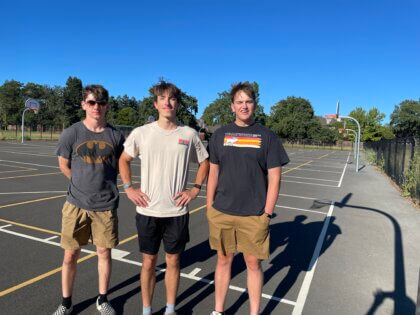They kept their heads, and saved their friend’s life
By Sarah Ford — On a balmy evening in mid-June, some recent Sonoma Valley High School grads met up to play basketball on one of the high school’s new outdoor courts. They were classmates from the class of 2020, with one younger boy, Mikey Serbicki, who just graduated. After a couple of hours of basketball, the sun was setting and they knew it would be their last game. Suddenly Mikey threw the ball wildly out of bounds, then said he was tired and sat down.

One of the three older boys who were still there, Mason Matulaitis, went to retrieve the ball, then turned and saw Mikey sprawled on the ground. The other two – Nate Jordan and Toby Ford-Monroe – had seen Mikey sit down and fall back. “He looked like he was relaxing,” Nate said. They called out to him, “Let’s go, Mikey.”
Mason came over to Mikey and tickled his stomach. When he got no reaction, he knew something was wrong.
“That’s when it started to get serious,” he said.
Mason saw that Mikey looked unwell, and checked the boy’s carotid artery in his neck, then put his ear to his chest, but couldn’t find a pulse. The other two ran over, and all three saw that Mikey’s face and lips were starting to look discolored and that his eyes had rolled back. “We immediately knew something was seriously wrong,” Toby said.
While he called 911, Mason began chest compressions and Nate ran to get the nearby automatic external defibrillator (AED) device, newly installed next to the courts.
(Remarkably, the device had been donated to the school by the parents who lost their own 16-year-old son to cardiac arrest on a basketball court.)
With the compressions, Mikey was taking large gasps of air. Meanwhile, Nate was hooking up the defibrillator. “It tells you what to do once it’s turned on,” he said, “And there are pictures on the pads that show where to place them on the body.”
Mikey got several shocks, with compressions between each one. Nate relieved Mason on the compressions, which are tiring.
By then an ambulance had arrived, and a helicopter had landed on the next court over. The paramedics took over the chest compressions, and attached their own defibrillator. Soon they put Mikey in the helicopter, transporting him to Santa Rosa Memorial Hospital, which has a trauma unit.
After 24 hours in Santa Rosa, where preliminary tests were done, Mikey was transported by helicopter to the pediatric cardiology unit of the UCSF Benioff Children’s Hospital, where he was brought out of sedation. He opened his eyes, and was immediately able to breathe and talk normally.
Since then he has undergone a series of tests and procedures to determine the cause of his cardiac arrest. All indications point to a previously undiagnosed heart condition, which they can now treat.
What’s clear is that many factors came together to ensure Mikey’s recovery, including a prompt response from emergency personnel, an accessible and user-friendly AED machine, and three brave young men who knew what to do.






